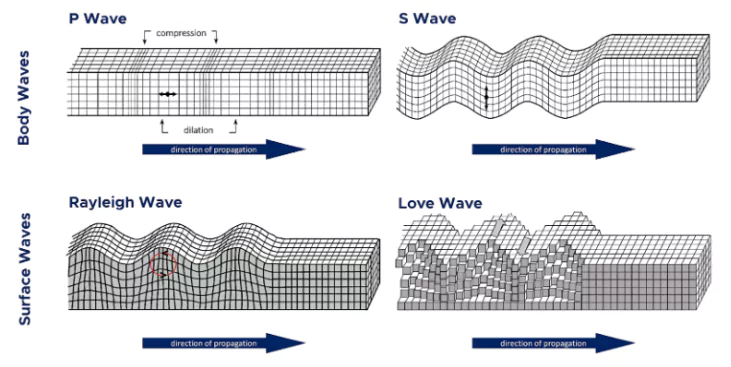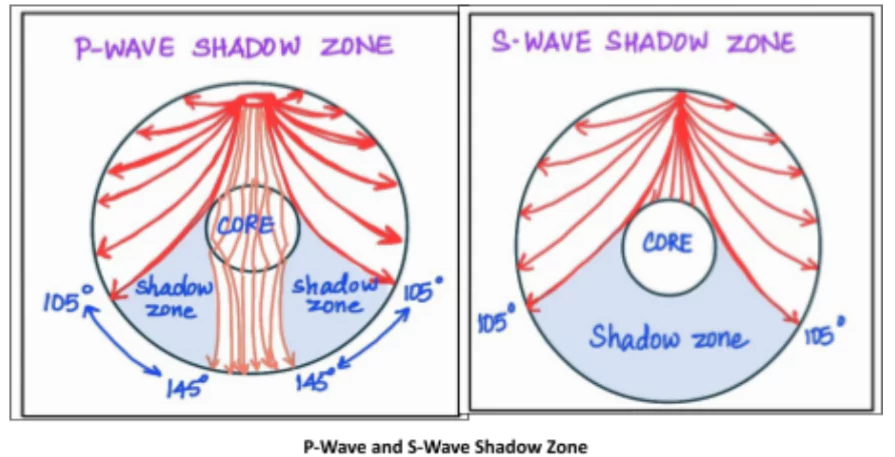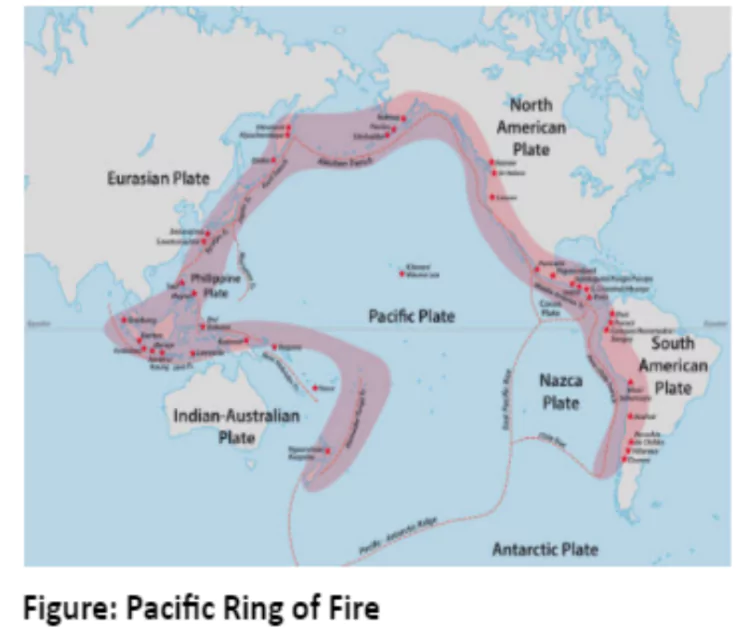An earthquake is the shaking of the earth triggered by the release of energy, which creates waves radiating in all directions. All natural earthquakes arise within the lithosphere, i.e., up to a depth of 200 km from the earth’s surface.
Earthquake Measurement
- Focus/Hypocentre: Point inside the earth where the earthquake originates.
- Epicenter: point on the earth’s surface directly above the focus. It’s the point where the earthquake waves are felt first.
- Richter Scale: It is based on the amplitude of the largest wave recorded on a specific type of seismometer and the distance between the earthquake and the seismometer.
- It is used to rate the magnitude of an earthquake, and the amount of energy released during an earthquake.
- The Richter scale is a base-10 logarithmic scale.
- Each order of magnitude is 10 times more intensive than the last one
- Moment Magnitude Scale: The Richter scale, does not provide accurate estimates for large-magnitude earthquakes.
- It is based on the total moment release of the earthquake.
- It is capable of measuring M8 and greater events accurately.
- Mercalli Scale: It measures the strength or intensity of an earthquake
- It is useful for understanding the visible damage caused by large earthquakes.
- Range: Measures intensity on a scale from 1-12.
- Seismograph: It is an instrument used to record the motion of the ground during an earthquake.
- They are installed in the ground all over the world and function as components of a seismographic network.
- A seismometer is the internal part of the seismograph, either a pendulum or a mass mounted on a spring
Enroll now for UPSC Online Course
Earthquake Waves

- Body Waves: Emanate from the focus and traverse through the earth; travel only through the interior of the earth.
- They are of two types- Primary Waves (P-waves) and Secondary Waves (S-waves)
- Surface Waves: Originate from the interaction of body waves with the surface; move along the earth’s surface;
- Recorded last of all the waves on the seismograph; more destructive.
- They are of 2 types- Love waves (L-waves) and Rayleigh waves (R-waves).
Speed of different waves: primary waves > secondary waves > love waves > rayleigh waves.
| Type of Wave |
Wave Motion |
Speed |
Mediums Travelled Through |
Shadow Zone |
| P-Waves |
Body wave, Longitudinal
(particle vibrates parallel to the wave direction) |
Faster than S-waves |
Solid, Liquid, Gas |
Yes, between 105° and 145° from epicentre |
| S-Waves |
Body wave, Transverse
(particle vibrates perpendicular to the wave direction) |
Slower than P-waves |
Solid |
Yes, beyond 105° from the epicenter |
| Love (L-Waves) |
Surface wave, Transverse |
Faster than Rayleigh waves |
Solid |
NA |
| Rayleigh (R-Waves) |
Surface waves, Both Transverse & Longitudinal |
Slower than Love waves |
Solid(faster), Liquid(slower) |
NA |
Shadow Zone

- It is an area on the earth’s surface where certain earthquake waves aren’t detected.
- Seismographs within 105° of the epicenter detect both P and S-waves.
- Beyond 145°, only P-waves are recorded.
- The zone between 105° and 145° is the shadow zone for both waves;
- The S-wave shadow zone (covering 40% of the earth’s surface) covers a larger area.
Types of Earthquakes
- Tectonic Earthquakes: Most common, caused by rock movement along fault planes.
- Example: San Andreas Fault in California.
- Volcanic Earthquakes: Linked to volcanic activity, triggered by magma movement.
- Example: Earthquakes around active volcanoes like Mount Vesuvius.
- Collapse Earthquakes: Minor quakes from sudden underground collapse in mining areas.
- Example: Mining regions experiencing subsidence.
 Explosion Earthquakes: Human-induced seismic events from explosions.
Explosion Earthquakes: Human-induced seismic events from explosions. -
- Example: Nuclear testing sites.
- Reservoir-induced Earthquakes: Triggered by the weight of water in large dams.
- Example: Reservoir induced seismicity near Koyna Dam (Maharashtra)
Distribution of Earthquakes
- Mid oceanic ridges (Eg: Atlantic ocean); Alpine-Himalayan system and the Pacific Ocean Ring of Fire.
- Earthquakes in mid-oceanic ridge areas are shallow, while those along the Alpine-Himalayan belt and Pacific rim are deep-seated.
Conclusion
Earthquakes are natural phenomena that can cause significant damage and loss of life. They result from the sudden release of energy in the Earth’s crust, often along fault lines. Preparedness, early warning systems, resilient infrastructure, and collaboration between scientists, engineers, governments, and the public are essential for effective earthquake risk reduction and response efforts.
![]() April 26, 2024
April 26, 2024
![]() 1423
1423
![]() 0
0


 Explosion Earthquakes: Human-induced seismic events from explosions.
Explosion Earthquakes: Human-induced seismic events from explosions.